Iowa’s rolling plains are a blackbird’s idea of paradise! Many of these birds favor tall grasses and open fields.
Others love the plowed furrows of a farm, or the marshy areas around rivers, streams, and ponds.
It’s easy to see why Iowa has such an abundance of blackbirds–and the opportunity to see 12 different species from this unique family, called the Icteridae.
So just what is it that makes a blackbird a blackbird?
Not All Black Birds are Blackbirds
You might expect that a family of blackbirds would be named for its glossy black wings, but when it comes to their scientific name, they’re actually not.
The name “Icterid” means “the jaundiced ones”, which sounds none-too-flattering! It refers to the flashy yellow feathers that many members of the blackbird family also have.
In addition to these bright yellow patch feathers, many blackbirds have extremely colorful bodies, thanks to their natural iridescence. Their black wings can show flashes of many other colors, including ranges of blues, greens, and purples.
Blackbirds are good at finding trouble, whether with humans or each other. They scavenge food, expand into urban areas, and shoulder their way into neighborhood bird feeders.
Some even lay their eggs in other birds’ nests during the breeding season! Others practice social domination to get the best breeding grounds.
Let’s get to know these flashy, feisty, and sometimes aggressive birds of Iowa!
Yellow-Headed Blackbird
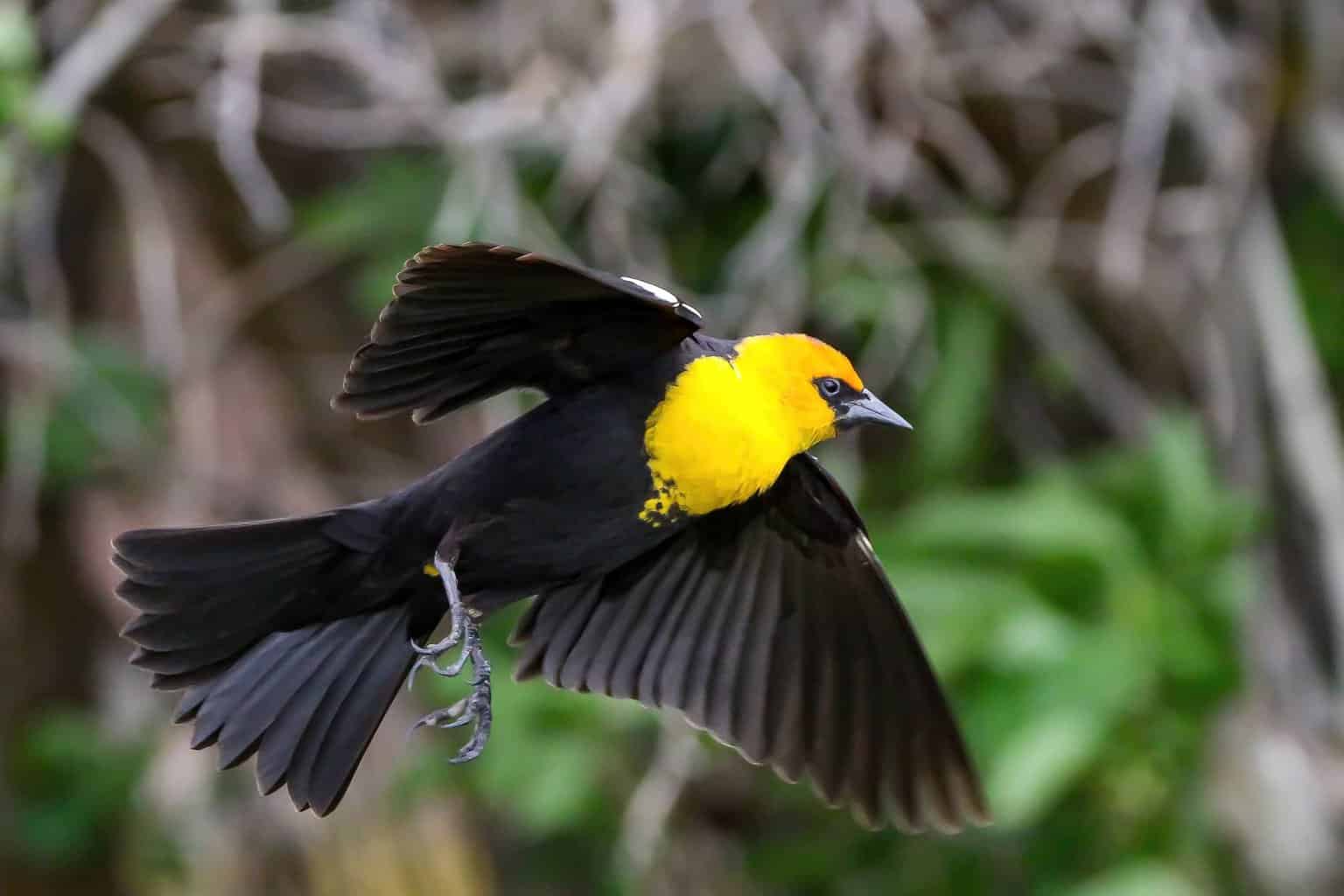
- Length: 8.3 – 10.2 in
- Weight: 1.6 – 3.5 oz (44 – 100 g)
- Wingspan: 16.5 – 17.3 in (42 – 44 cm)
Color Pattern: Males have vivid yellow heads and chests that contrast with their sleek black wings and bodies. White wing bars mark the bend of each wing.
Females sport a duller shade of yellow patches and have brown bodies with slight streaking, rather than black.
Male Yellow-Headed Blackbirds migrate to Iowa in April to begin seeking out good territories for breeding season and nesting. The females follow them in May, and they’ll reside in the area throughout the summer.
These striking birds can make some strange noises–their call has been described as similar to the sound of a chain saw! Listen and decide what you think it sounds like.
Yellow-Headed Blackbirds and Red-Winged Blackbirds favor the same marsh habitats for nesting. But the Yellow-Headed Blackbirds are socially dominant and will push the smaller Red-Wings out of the prime nesting spots.
Bobolink
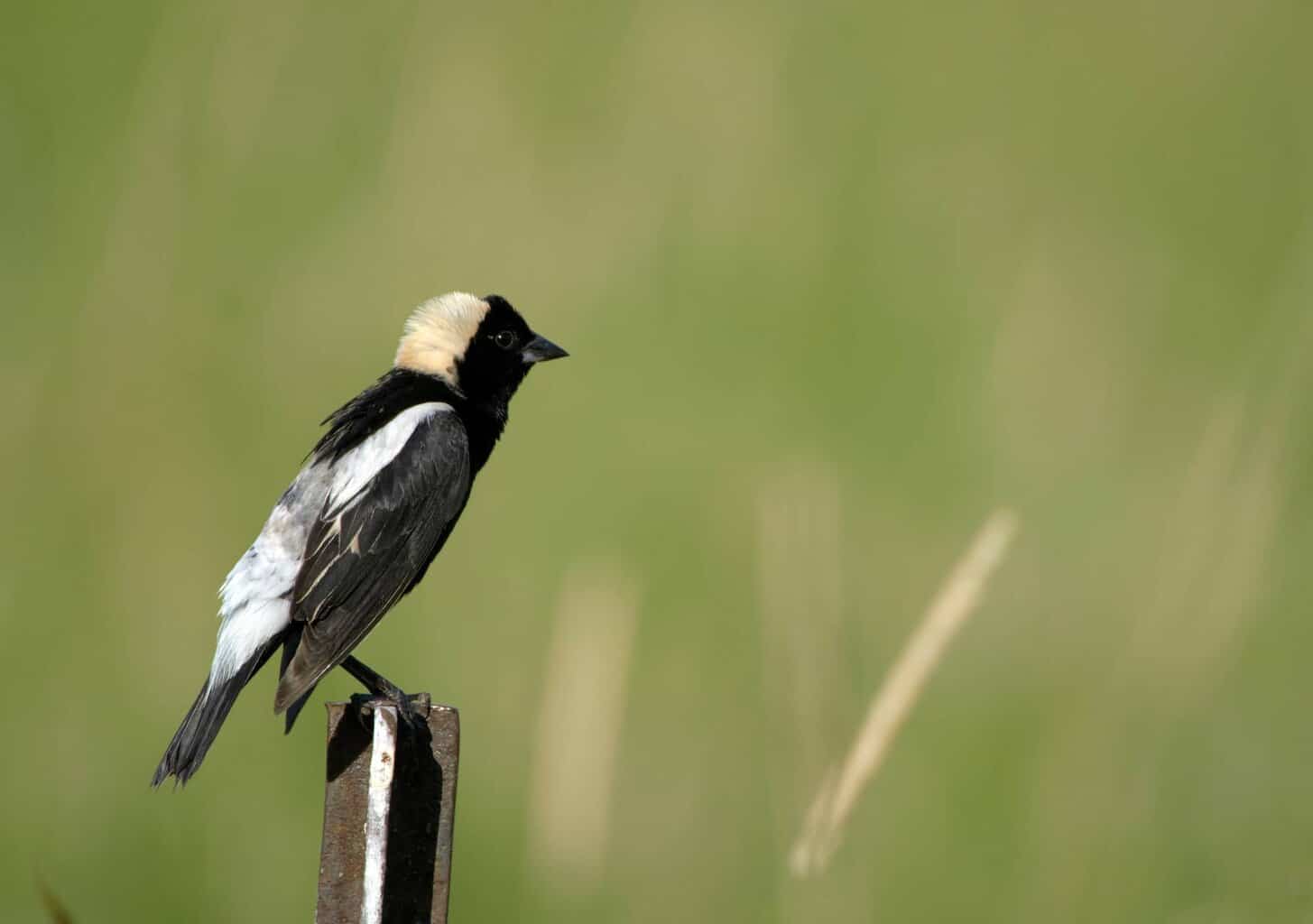
- Length: 5.9 – 8.3 in (15 – 21 cm)
- Weight: 1.0 – 2.0 oz (29 – 56 g)
- Wingspan: 10.6 in (27 cm)
Color Pattern: When in their breeding plumage, males have predominantly black wings, with a yellow ochre nape, and white on their backs and rumps.
This is the only bird in North America that is white on its upper side and black on its underside.
When not breeding, the males look like the females: a warm, tawny body streaked with dark brown on their backs and flanks. They have brown-striped crowns and pinkish bills.
The Bobolink has been declining in Iowa because of the destruction of its tall grassland habitat.
An important tip for Bobolink survival is delaying hay mowing until late July or early August, to allow baby Bobolinks in field nests time to fledge during the breeding season.
Bobolinks are amazing travelers. These non-aggressive birds fly a distance equivalent to 4 or 5 times the earth’s circumference in their lifetimes.
They are the only mainland birds known to take a migration route through the Galápagos Islands each year in massive flocks.
Western Meadowlark
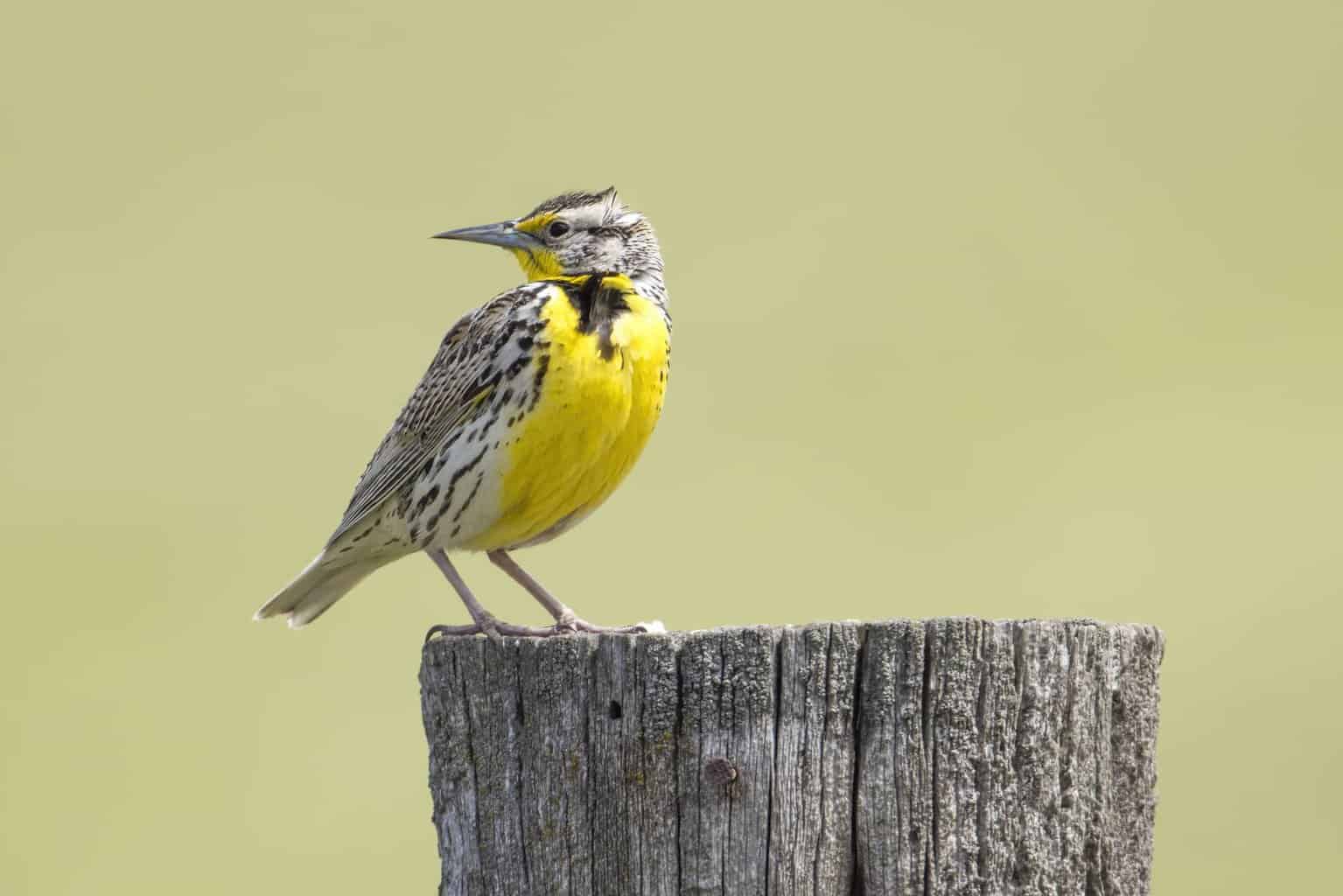
- Length: 6.3 – 10.2 in (16 – 26 cm)
- Weight: 3.1 – 4.1 oz (89 – 115 g)
- Wingspan: 16.1 in (41 cm)
Color Pattern: Bright yellow undersides with a distinctive black V at the breast that turns gray in winter.
The rest of the body has detailed patterning in slight streaking of brown, black, and cream. They have striped brown heads that are mixed with cream, and the outer tail feathers look white in flight.
The Western Meadowlark had some famous friends. It was first noted by the explorer Merriweather Lewis that this bird was different from its Eastern counterpart.
John James Audubon was the one to bestow its scientific name, Sturnella neglecta.
Female Western Meadowlarks do most of the tending to the young by themselves. The males are too busy–they usually have two mates at the same time!
Eastern Meadowlark
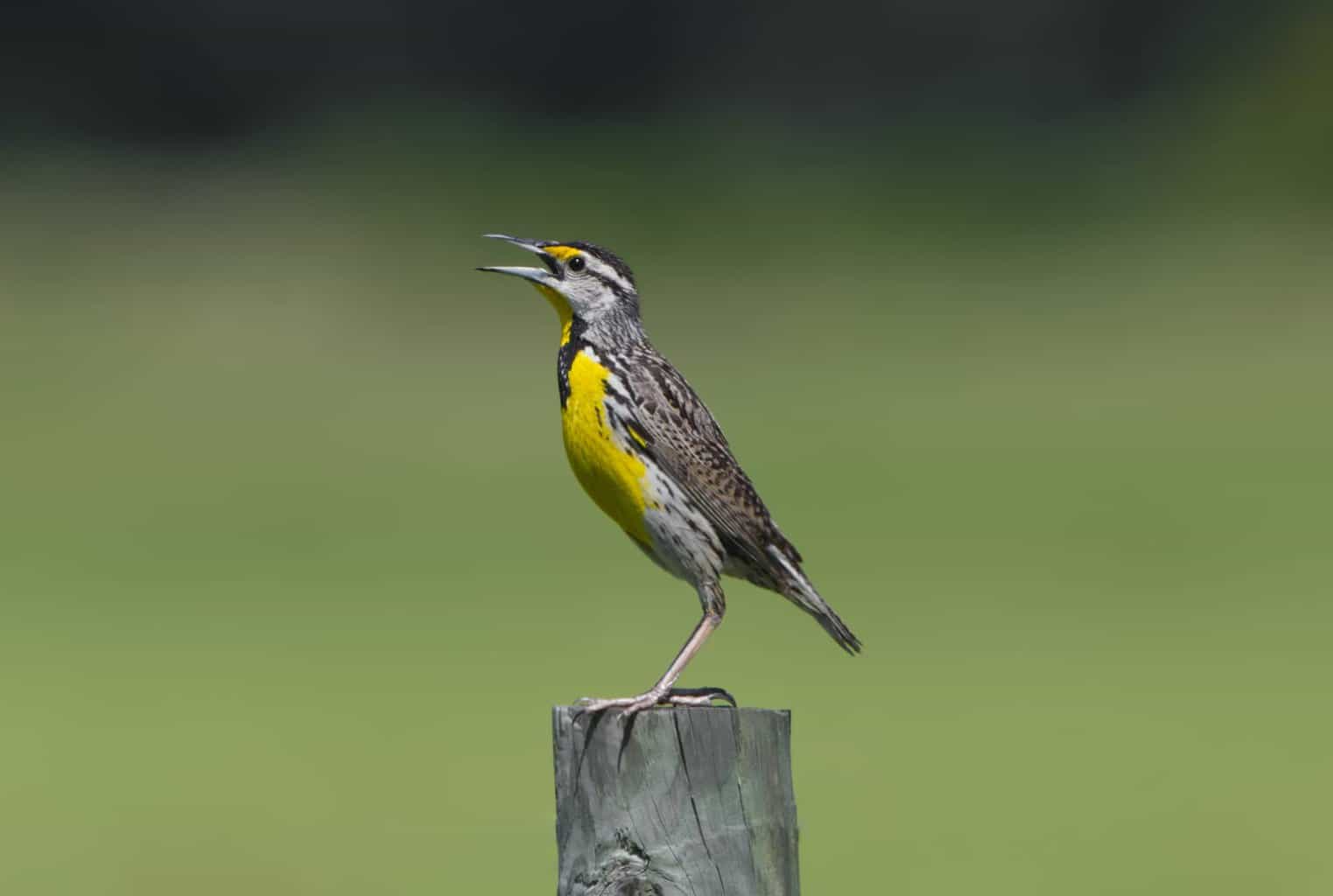
- Length: 7.5 – 10.2 in (19 – 26 cm)
- Weight: 3.2 – 5.3 oz (90 – 150 g)
- Wingspan: 13.8 – 15.8 in (35 – 40 cm)
Color Pattern: Eastern Meadowlarks have a sunny yellow breast with a distinctive black v-marking at the chest. The rest of the body is pale brown with black wing markings—including a brown head. The tail is brown with blackish barring, and white outer feathers that become noticeable during flight.
The Eastern Meadowlark may be a little more mysterious than your average blackbird. They’re not as common to see at your neighborhood backyard feeders and are not aggressive birds.
It’s not easy to find an Eastern Meadowlark’s nest: these birds will walk back to their nests through narrow grass runways, rather than fly.
Eastern Meadowlarks are a great friend to farmers. They will eat harmful insects, using a special behavior called “gaping” to expose them to the ground, while leaving the crops alone.
Baltimore Oriole

- Length: 6.7 – 7.5 in (17 – 19 cm)
- Weight: 1.1 – 1.4 oz (30 – 40 g)
- Wingspan: 9.1 – 11.8 in (23 – 30 cm)
Color Pattern: The adult males have striking hot orange undersides, and a black hood, back, and wings. Baltimore Orioles have white wing bars and white slight streaking on the wings.
Adult female Baltimore Orioles are olive to gray on their backs with subdued yellowish-orange undersides. They share the white wing bars and slight streaking of the males. Juvenile Baltimore Orioles share the female coloration.
Baltimore Orioles and their Orchard Oriole cousins make their migration to Iowa in late April and early May during the breeding season.
Upon their arrival, Baltimore Orioles seek out their favorite sugary snacks, like nectar, fruit, and jelly. Then they’ll mate and build intricately-woven hanging nests for their young in a variety of habitats.
Orchard Oriole
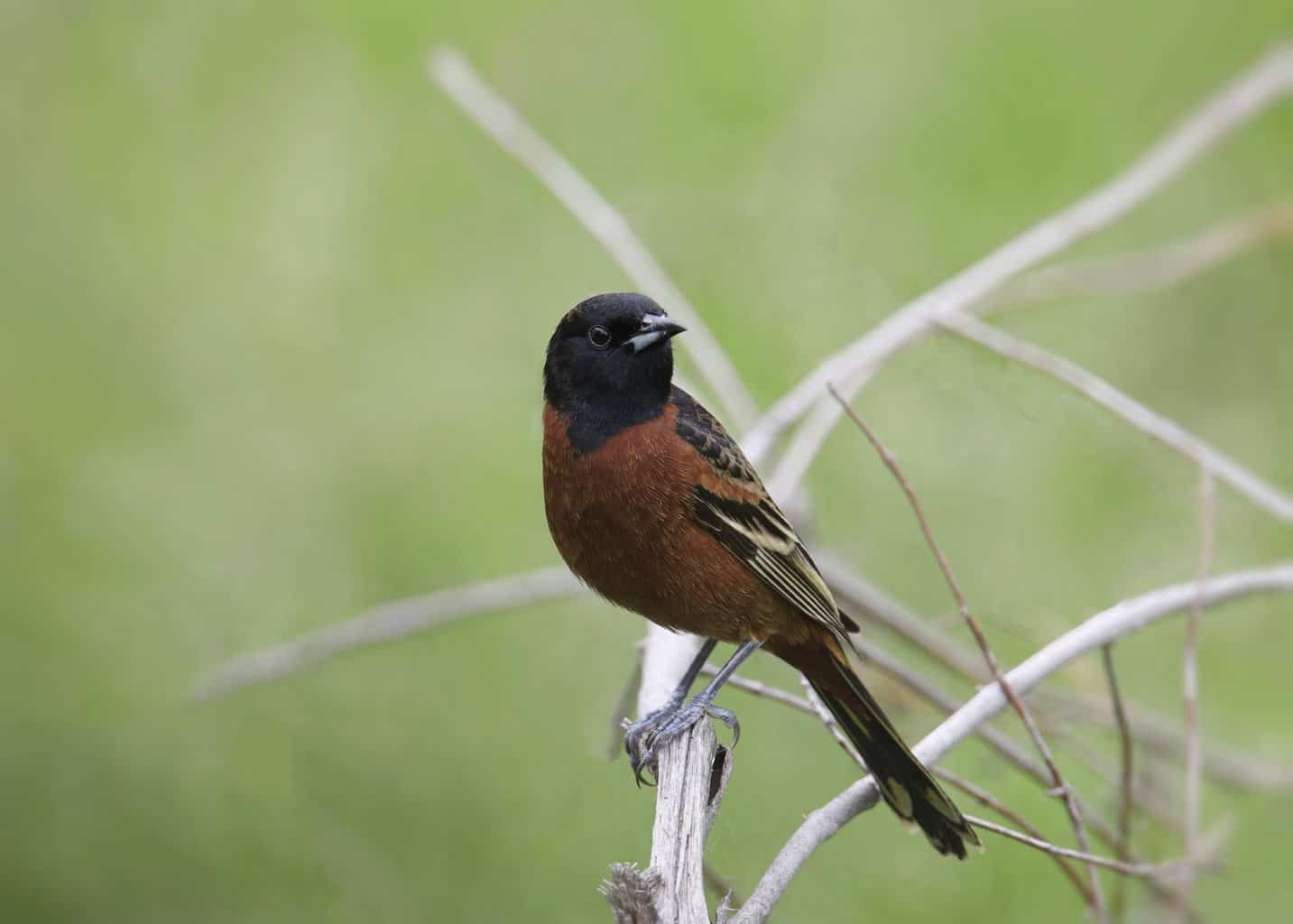
- Length: 5.9 – 7.1 in (15 – 18 cm)
- Weight: 0.6 – 1.0 oz (16 – 28 g)
- Wingspan: 9.8 in (25 cm)
Color Pattern: The adult male is black on top from hood to tail, with a deep chestnut-colored underside. There is a chestnut-colored patch on each wing, with white streaking along the wing feathers.
The adult females have an olive-to-yellow back that gets more yellow on the underside. Their wings are grayish and marked with two white wing bars; unlike the males, they have no black markings.
Juveniles are similar to females, but immature males have black markings on their faces.
Just like Baltimore Orioles, Orchard Orioles come to Iowa in late spring and early summer, hunting for a sugar rush. But they’re not aggressive birds and are shy about neighborhood backyard bird feeders and residential areas, so you might not see them as often.
Orchard Orioles also love to eat spiders and insects, so a bug-friendly, neighborhood backyard might attract them.
Orchard Orioles are friendly with many other species of birds, including Eastern and Western Kingbirds. That friendship might help protect them from parasitism by cowbirds.
Red-Winged Blackbird
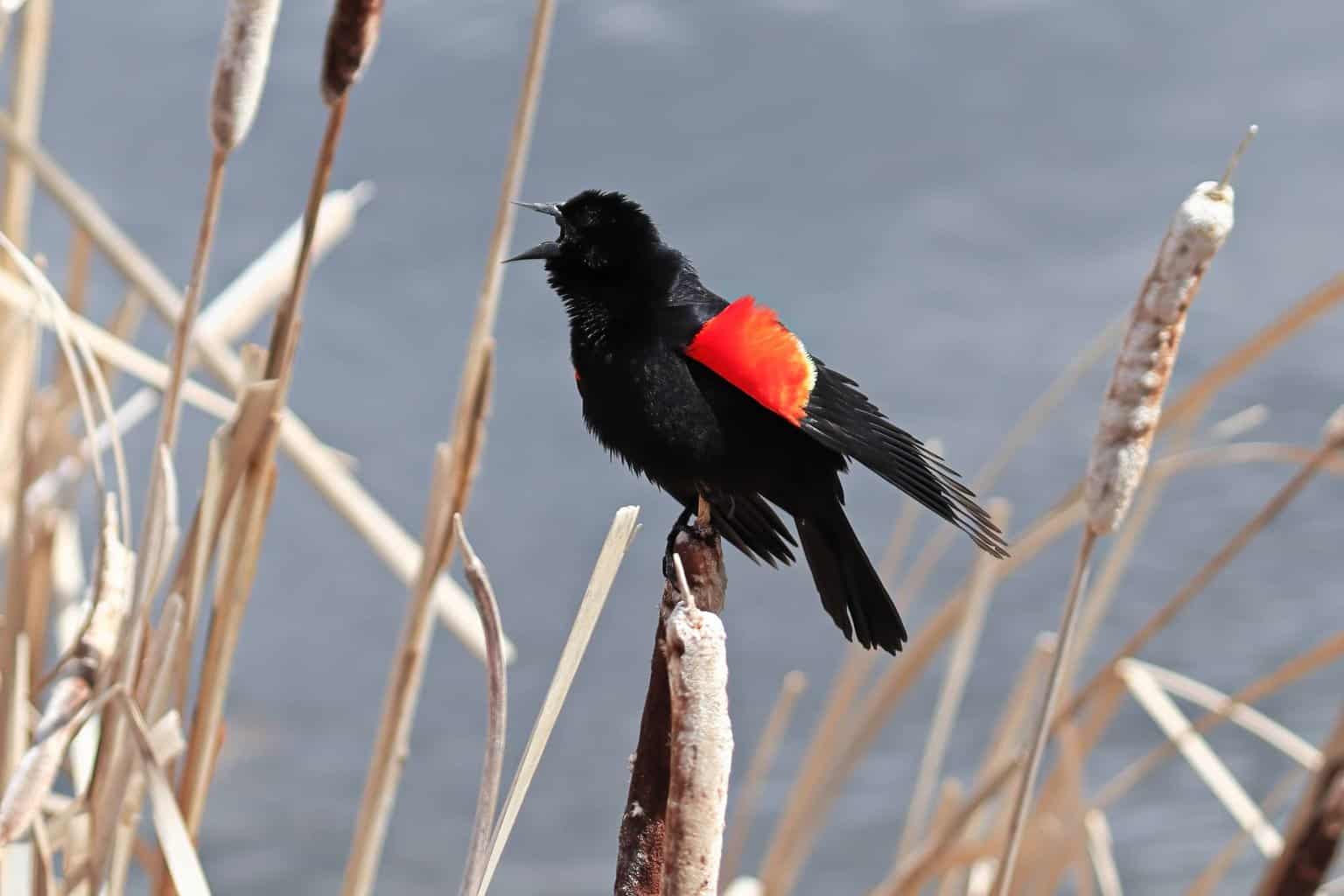
- Weight: 1.1 – 2.7 oz (32 – 77 g)
- Wingspan: 12.2 – 15.8 in (31 – 40 cm)
Color Pattern: The males are striking in appearance, with glossy black bodies, and red and yellow markings on the curve of each shoulder.
Females are dark brown—with brown heads—overall, with clean white streaks, a pale breast, and often, a white eyebrow.
The Red-Winged Blackbird is one of the most abundant birds in Iowa, and there are both migratory and resident Red-Wings in the state. They nest in a variety of habitats and are not aggressive birds.
Even though male Red-Winged Blackbirds are aggressive birds and will fiercely defend territories with as many as 15 female mates, the chicks from one nest often have several different fathers.
Red-Winged Blackbirds will sometimes be the victims of the next bird, the Brown-Headed Cowbird when it lays its eggs in its nests during the breeding season.
Brown-Headed Cowbird
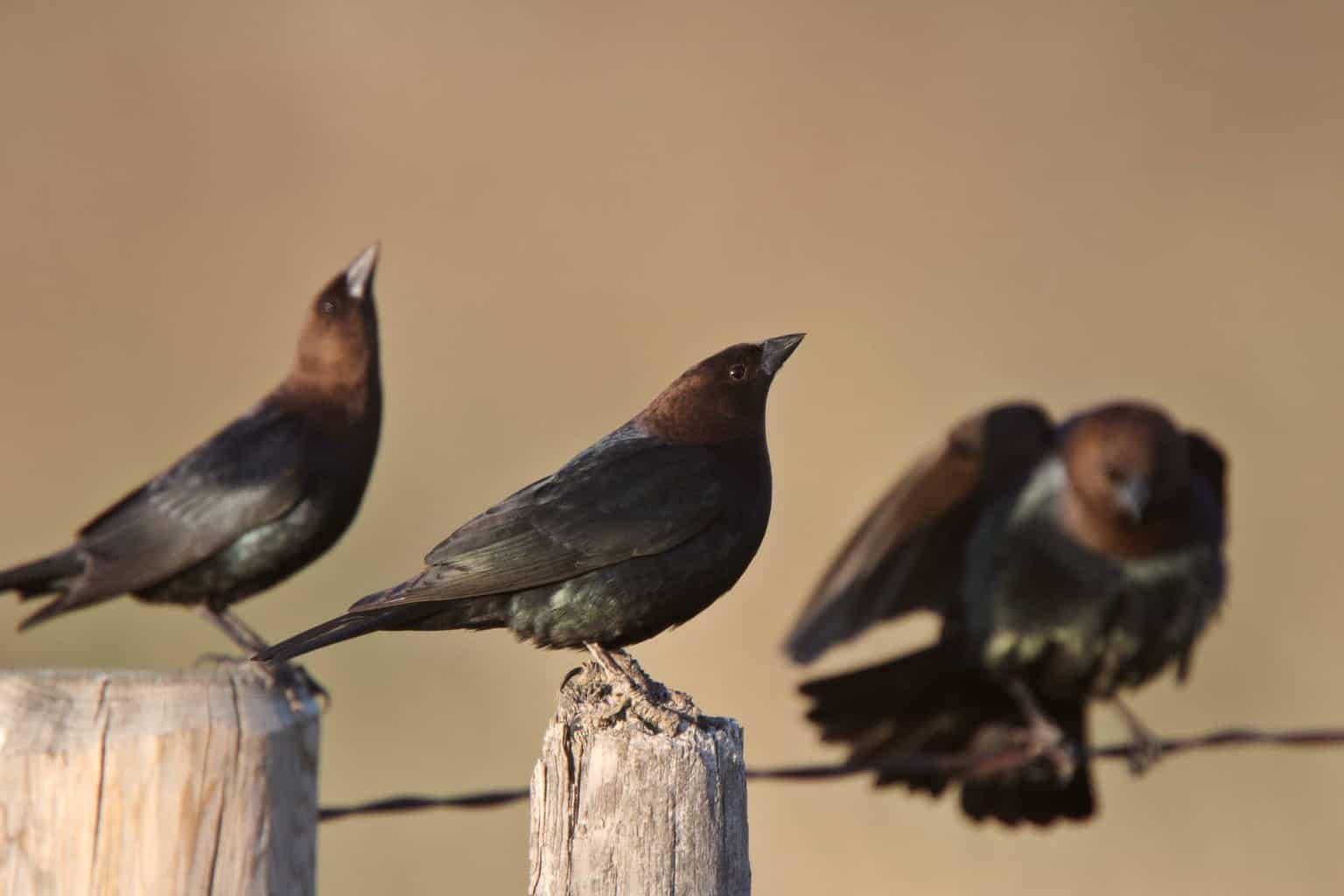
Male
- Length: 7.5 – 8.7 in (19 – 22 cm)
- Weight: 1.5 – 1.8 oz (42 – 50 g)
- Wingspan: 14.2 in (36 cm)
Female
- Length: 6.3 – 7.9 in (16 – 20 cm)
- Weight: 1.3 – 1.6 oz (38 – 45 g)
- Wingspan: 12.6 – 15.0 in (32 – 38 cm)
Color Pattern: Males have glossy black feathers all over their bodies, and a deep brown head that can look black from a distance.
Females are entirely brown, but lighter on their heads and undersides. They have dark eyes and fine streaks on their bellies.
The Brown-Headed Cowbird comes to Iowa for nesting season–except they’re not the ones building the nests!
The most distinctive trait of Brown-Headed Cowbirds is that they are brood parasites: that is, they lay their eggs in other birds’ nests in a variety of habitats. They then make their chicks someone else’s problem!
The Brown-Headed Cowbirds as a whole aren’t picky about the adoptive parents they choose–they will lay their eggs in the nests of over 220 different host species. Because of this, the species is not a very aggressive bird!
But it seems that an individual female Brown-Headed Cowbird will select one host species to consistently lay her eggs with during the breeding season.
Rusty Blackbird
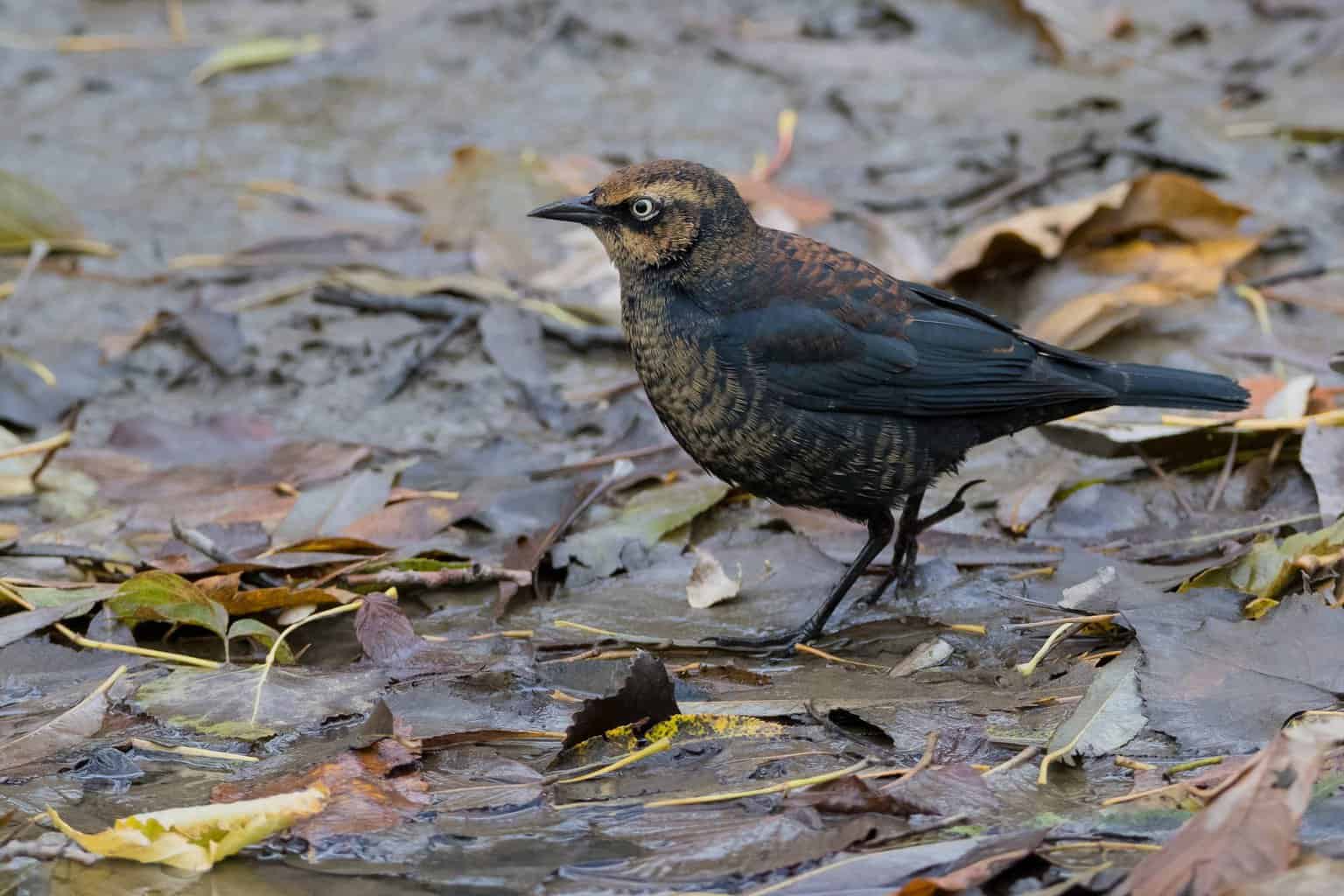
- Length: 8.3 – 9.8 in (21 – 25 cm)
- Weight: 1.7 – 2.8 oz (47 – 80 g)
- Wingspan: 14.6 in (37 cm)
Color Pattern: The Rusty Blackbird is recognizable by the rusty feather edges that are visible on both the non-breeding males and the females. Both also have pale yellow eyes. Non-breeding males have buffy eyebrows.
Female Rusty Blackbirds have gray-brown bodies and dark feathers surrounding the eye that contrast with a pale brow.
Breeding male Rusty Blackbirds are glossy black all over, with a greenish iridescent sheen on their beautiful plumage.
Rusty Blackbirds nest in the far north, then winter in Iowa and throughout the Mississippi River Valley, as well as along the Southern East Coast.
The Rusty Blackbird is in serious trouble. This bird’s numbers declined 85 to 95% over a span of 40 years–more than any other North American songbird.
Frustratingly, no one is certain why. Factors that could be contributing include habitat loss, mercury toxicity, pesticide runoff, and climate change causing wetlands to dry up.
The International Rusty Blackbird Working Group is studying these birds and trying to solve the troubling problem of their decline.
Common Grackle
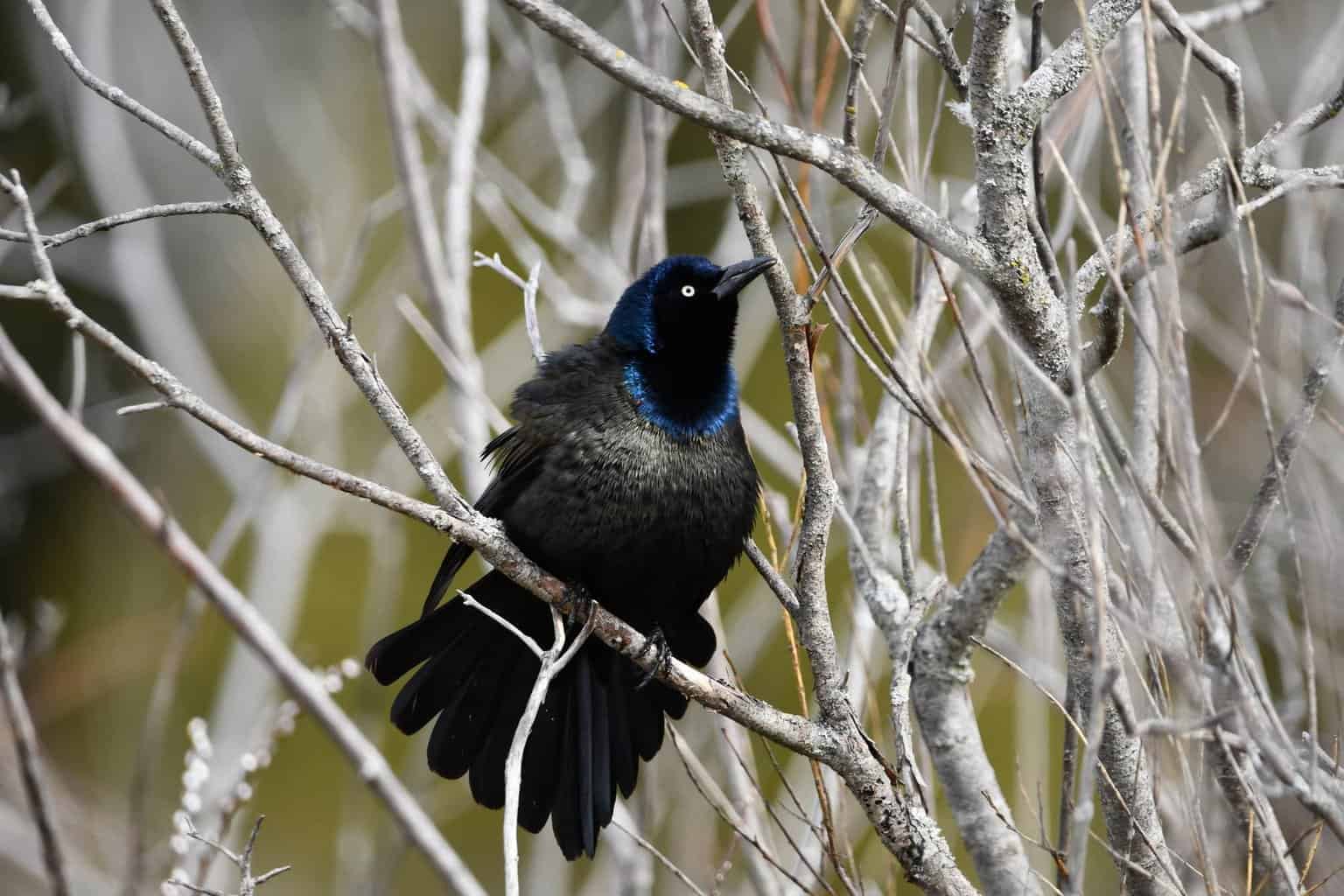
- Length: 11.0 – 13.4 in (28 – 34 cm)
- Weight: 2.6 – 5.0 oz (74 – 142 g)
- Wingspan: 14.2 – 18.1 in (36 – 46 cm)
Color Pattern: Common Grackles seem to be simply black, but iridescence gives them a wide array of colors under the right light.
Males have glossy purple heads and bronzing all over their bodies. Females aren’t as iridescent as the males, but still have some of that bronzing and multicolored sheen in their beautiful plumage.
Both adults have a light golden eye, but juveniles are born with a dark eye.
Common Grackles are intelligent, noisy birds that are known for their wide-ranging appetites and foraging skills.
They will eat just about anything, whether that means insects, seeds, vegetables, fish, eggs, or even other birds and small rodents.
These highly-social birds will form multi-species flocks in the winter with other types of blackbirds, sometimes including several million birds. They forage and spend the breeding season together.
Great-Tailed Grackle
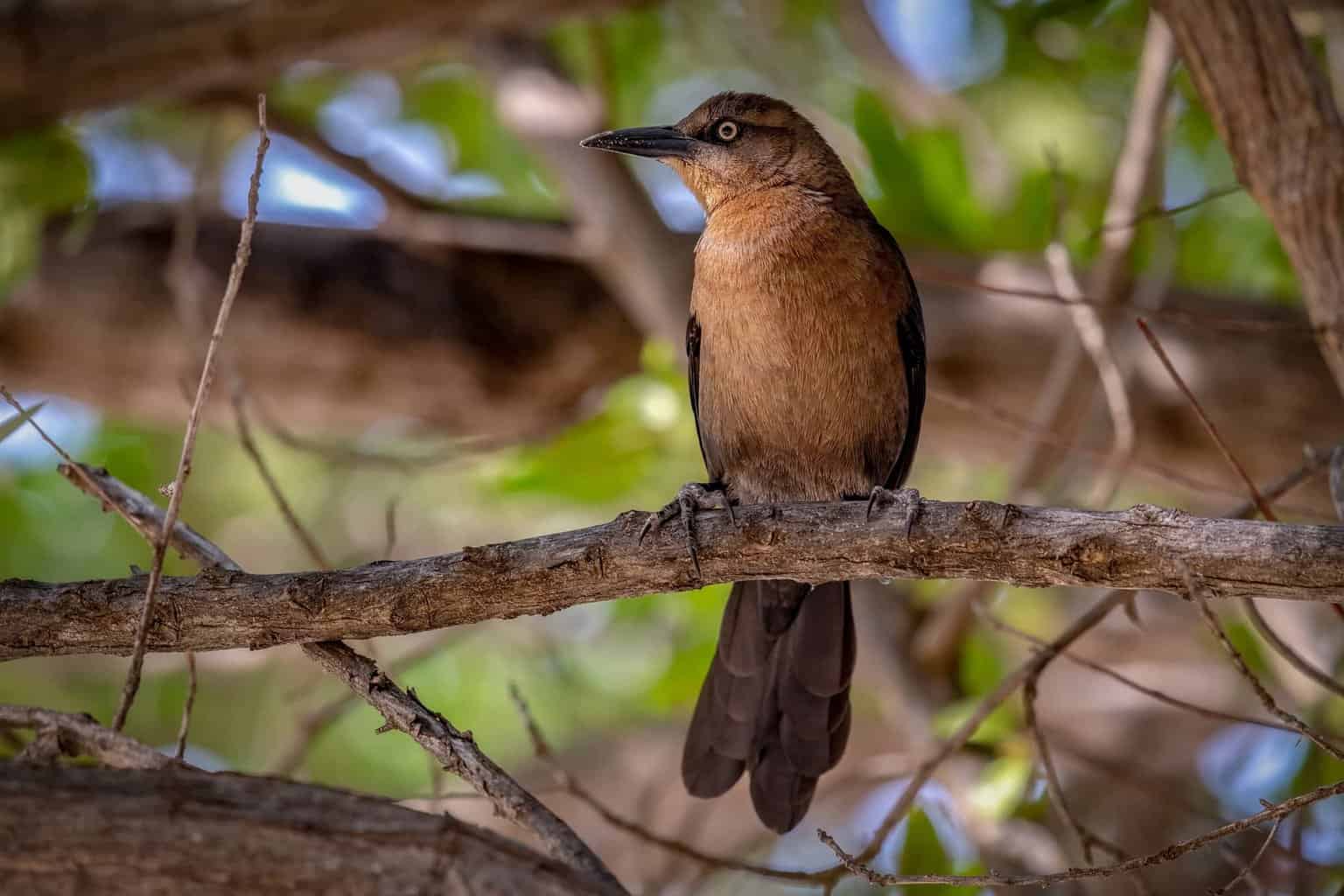
- Weight: 3.7 – 6.7 oz (105 – 190 g)
- Wingspan: 18.9 – 22.8 in (48 – 58 cm)
Color Pattern: Males are glossy black all over, including their bills and legs. Their feathers are iridescent. They have vivid yellow eyes.
Females are dark brown all over, with lighter white wing bars and a buff-colored throat. They have a dark eye with a stripe above. The juvenile birds share the female’s coloration, with streaking on their undersides and beautiful plumage.
This attention-grabbing bird is unusual in Iowa but has been expanding its range into the state in recent years. It’s more common in the southwestern US and Mexico.
Great-Tailed Grackles are intelligent, social birds and have demonstrated the ability to recognize individual humans who have performed research on their colonies.
Brewer’s Blackbird
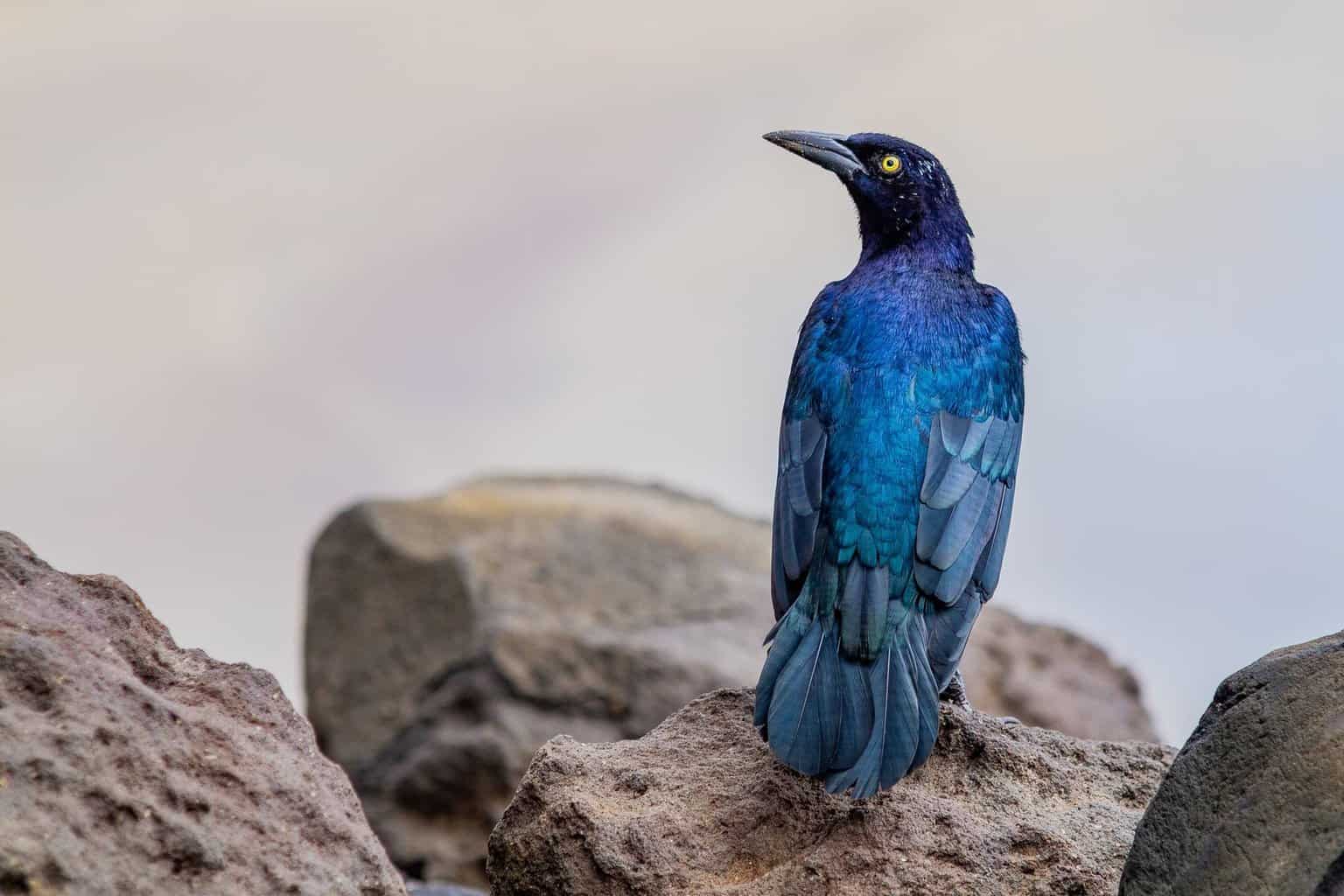
Male
- Length: 8.3 – 9.8 in (21 – 25 cm)
- Weight: 2.1 – 3.0 oz (60-86 g)
- Wingspan: 14.6 in (37 cm)
Female
- Length: 7.9 – 8.7 in (20 – 22 cm)
- Weight: 1.8 – 2.4 oz (50 – 67 g)
- Wingspan: 14.6 in (37 cm)
Color Pattern: Males are iridescent, glossy black that ranges from blues at the top of their head, down to greens lower on their body. They have striking yellow eyes.
Females are brown throughout, but darker on their tails and wings. They have dark eyes. Juveniles will look similar to the females, but with washed-out coloration. They have beautiful plumage!
Brewer’s Blackbirds adapt well to the human development of their habitat and don’t seem to mind sharing urban landscapes with us—they’re friendly and not aggressive birds!
Sadly, Brewer’s Blackbirds are sometimes killed to protect crops. But these birds are actually really important for controlling populations of pest insects by eating invaders like tent caterpillars, termites, and weevils.
They will even follow after farm machinery, looking for insects in the plowed earth.
Concluding Thoughts
Iowa has an abundance of blackbirds to see in all seasons and a variety of habitats. There are the year-round residents, the summer breeding season birds, and even the more unusual winter visitors.
Blackbirds offer a range of fascinating behaviors and interactions to reward the birder, and if you’re in Iowa, they’re your neighbors. Happy birding of these birds with beautiful plumage!

